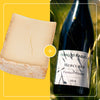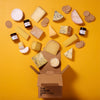What wine should you be drinking with your cheese?
By Rhiannon Davis
Aug 10, 2021

The Ultimate combo
I apologise in advance if you are reading this with a glass of port in one hand and a wedge of Stilton in the other. What I am about to talk about is, as always, outweighed by personal preference of course…if Port and Stilton floats your boat, then please don’t head back…to port (sorry).
Port and Stilton (this is not it)
As with so many things, Port and Stilton was a marriage of convenience rather than true romance. It was the 18th Century, and England and France were at war, which meant a shortage of French wine. Out of desperation, Londoners were forced to venture to Portuguese wine, which around that time was being fortified with brandy to make it more palatable. As these wines began to age and mellow, Londoners developed a taste for it. It was around this time that Stilton was growing in stature, the cheese to be seen with. And so it transpired, that in the ‘trendy’ circles within London, Port and Stilton became very de rigueur. Whether they complimented each other or not was neither here nor there.
And so the trend, over time, imprinted itself into English culture, and today we still assume, almost to the neglect of our taste buds, that Port and Stilton is THE ultimate pairing. Like I said, please do enjoy if you are currently partaking…but try and let your taste buds have a say.
Malolactic Fermentation aka MLF
So if Port and Stilton is not the be all and end all, where should we be looking. Well, the answer to that lies in science really….more specifically malolactic fermentation (or strictly speaking malolactic conversion if you want to get really geeky). Most red wines worth their salt undergo some degree of malolactic fermentation (MLF), but it is far rarer with white wine. In fact, the only white wine grape that really benefits from MLF is Chardonnay, whilst many grapes (eg Chenin Blanc, Riesling) don’t get on with it at all. So what is MLF all about, and what does it have to do with cheese?
Well, MLF is the process by which malic acid, naturally present in new wine, converts to lactic acid. For those cheese geeks out there, bells will be starting to go off in your head now, like when you suddenly realise who the killer must be in that episode of Poirot. Making milk, into cheese, relies on converting lactose (present in milk) to lactic acid. So, we have a synergy here between wine and cheese. What’s more, when MLF takes place, it produces the buttery-smelling Diacetyl. So, wines that have been exposed to MLF develop a rounded, buttery, smooth flavour that is chemically similar to the process of cheesemaking, and matches the taste profile of cheese…ie rich dairy. Making wine and cheeses with similar taste profiles incredibly well matched.
Sparkling, white wine and cheese
It is this foundation that I use to guide how I pair wine with cheese. Malic acid produces those acidic, sharp, fresh, unripe flavours in wine, which is why wines that avoid MLF do so to maintain that crispness and fresh zing. Conversely, a lightly oaked Chardonnay, thanks to the barrels the wine has been aged in, will benefit from more rounded, smooth, creamy, buttery flavour profiles.
Therefore, it makes perfect sense to pair a sharp, zingy Sancerre with an acidic, fresh goat’s cheese from the Loire, just like it makes sense to match a subtly rich, rounded, oaked Chardonnay with a creamy rich soft cheese like Baron Bigod or Tunworth (Brie or Camembert style cheeses). Of course, the famous saying goes ‘What grows together, goes together’, and there are many reasons for this, none more so than the shared terroir that gives the produce their heart and soul. Sancerre and Loire goat’s milk cheese is one of the most famous examples of this, and so to match that, try Hattingley Valley and Tunworth, both within a stone’s throw of each other in Hampshire. Because the same goes for champagne when it comes from benefitting from MLF. One of my absolute favourite pairings is an aged Gruyere with Laurent Perrier. The richness of the champagne, as well as the biscuit, yeasty notes that come from ageing on the lees just works so beautifully with the many mirrored flavours within the cheese.
As I always say, a good pairing avoids any clashes or battles. But a great pairing serves to elevate all the subtleties within each element, raising both the cheese, and the wine, to new levels. Aged Gruyere and Laurent Perrier is certainly one of those pairings.
Red wine and cheese
So far, all white wines and sparkling. What about the red wine?? After all, as mentioned earlier, most good reds to benefit from MLF. Well, the difficulty with red wine is the tannins, which can clash with cheese and provide some nasty surprises. White wine is certainly the safer bet when it comes to an all-rounder. If you had one bottle of wine, and 5-6 varieties of cheese, I would choose an oaked Chardonnay. But, with care, there are of course many wonderful red wine and cheese pairings, you just need cheeses that do pack a big enough punch to hold their own. Usually, hard aged cheeses are your best bet.
I remember a great tasting of a New World Cabernet Sauvignon (California) and Montgomery’s cheddar, and then a Bordeaux paired with St Nectaire. What was so great about the two pairings wasn’t so much that each one was fantastic…but that when I swapped the wines, the pairings just didn’t work. The difference in sunshine hours, ripeness of the grapes, and the acidity made all the difference when it came to matching with the cheeses. The Californian Cabernet had the most wonderful rounded finish, and the tannins were complemented by the meaty, saltiness of the cheese. The Bordeaux however, with it’s more leathery, tobacco, savoury notes served to accentuate the saltiness in the cheese, and it all became over-seasoned. The St Nectaire however was happy to play along with the Bordeaux, bringing some subtle, vegetal, fresh grass notes that didn’t clash with the wine, but served to add more complexity and intrigue. These nuanced dynamics are everywhere, and you don’t sometimes really realise what a great pairing is until you have found one…and you realise the others have simply been good.
Another great pairing that always springs to mind, and far more accessible, would be Old Winchester and Montepulciano D’Abruzzo. No frills, nothing fancy, just a duo that get along…really really well.
Blue cheese and wine
So we have covered white, sparkling and red wine, as well as fresh goat’s milk cheeses, soft cheeses and hard mature cheeses. All that is left really is the blue cheeses. With all of our pairings, we are looking to achieve one of two things. Complementary flavours, or opposites attracting. For the most part, I tend to play it safe and go complementary. However, there is nothing quite like the salty and sweet of a strong blue cheese, and a Sancerre, or high quality dessert wine. In many ways the runts of their litter, or at best misunderstood, blue cheese has suffered from poor quality, pre cut wedges in the supermarket, and sweet wine has suffered from the cheap cloying garbage that you can get (probably from the same supermarket) at a cheap price. Neither have done anything to help the nation’s fondness of blue cheese, or sweet wine. However, I challenge anyone to try a wedge of top quality Roquefort (or closer to home, Mrs Bell’s Blue or Crozier Blue) and a glass of Sancerre, and tell me to my face it doesn’t create magic in their mouth. The delicate honey sweetness of the wine, ideally nice and chilled, cutting through the saltiness of the cheese is to die for. It is one of the great combinations in food and drink. Similar results can be achieved with many blue cheeses, but sheep’s milk blue cheese works particularly well as behind the salty blueing, it tends to hide an extremely subtle milky, honey, nutty sweetness that is so masterfully revealed by a Sancerre, or similar sweet wine. It is quite simply the perfect way to end any tasting.
But remember, these are all just tips…give your own tastebuds a chance to make the decisions, and experiment. There is no better way to find great pairings (other than perhaps The Ultimate ☺).
That brings us to the ultimate pairing. Eight award-winning cheeses and eight fine wines delivered to your door, hand-selected by the cheesegeek himself. Run your own tasting with our extensive tasting guide and scorecards. Limited stocks in place so head to the site to buy now.


